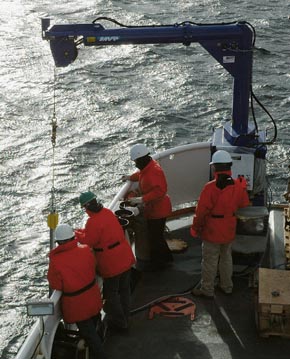Groundfish Assessment Program
Free-Fall Cone Penetrometer Tested Near Halifax

Figure 1. Free-fall cone penetrometer (FFCPT) being deployed with free-fall winch.
Photo by Robert McConnaughey. |
|
The RACE Division participated in sea trials of a free-fall cone penetrometer (FFCPT) (Fig 1). This technology is being
developed for groundtruthing of Alaska fish habitat from an underway vessel. The 26-28 November cruise aboard the Canadian
Forces Auxiliary Vessel Quest was conducted by scientists and engineers with Defence R&D Canada (DRDC), a research
arm of the Canadian Navy, and Brooke Ocean Technologies Ltd. (BOT), manufacturer of the FFCPT. Quest is a 76-m
general-purpose research vessel with responsibility for evaluating prototype ocean systems with potential military applications.
Chief Scientist for the cruise was Dr. John Osler, Group Leader, Ocean Sensing and Modeling, DRDC Atlantic in Dartmouth, Nova
Scotia.
The FFCPT is a free-falling probe designed to measure in situ sediment properties. It is a 1.6-m long, 9-cm diameter cylinder
with modular sections for sensors, batteries, ballast, and data storage. The basic FFCPT weighs approximately 40 kg, with the
option of adding additional ballast for harder bottoms in deeper waters. The geotechnical sensors measure deceleration and
dynamic sediment pore pressure during penetration into the seabed, providing two independent means of calculating undrained
shear strength (a measure of resistance to deformation). During each drop of the probe, these data are recorded at a rate of
2,000 measurements per second. These same measurements can also be used to interpret the dominant sediment texture. A combined
sound velocity and pressure sensor is located above the stabilizing tail fin, and an optical backscatter sensor in the nose
cone senses the mud-water interface.
This leg of the Quest cruise left Halifax harbor on 26 November, after waiting for Hurricane Rita to pass through the
area, and proceeded along the south shore of Nova Scotia to the study area in St. Margaretís Bay. The overall objective was
to evaluate feasibility of underway geophysical sampling by integrating the FFCPT with a free-fall winch system. This
capability would enable more rapid environmental assessments than are possible with static on-station sampling and is a
requirement for NOAA deployments in Alaska because of the enormous area involved. For the first time, multiple-drop underway
sampling was accomplished in sand, silty sand, and silty bottoms at speeds of 3.5-6.0 kts. Maximum penetration of the probe
exceeded 2.5 m in the softest areas. Interestingly, the pull-out loads (kg) required to extract the FFCPT from the seabed
generally decreased as vessel speed increased.
The RACE Division, in cooperation with other NOAA line offices has already installed a free-fall winch on NOAA ship
Fairweather enabling underway sound velocity measurements during acoustic survey operations. A FFCPT will be added to
the system in Spring 2006, to aid interpretation of seabed characteristics in support of fish habitat research.
By Robert McConnaughey
>>>continued
 |

|
OND2005 quarterly sidebar
AFSC Quarterly
Research Reports Oct-Dec 2005
Contents
Feature
ABL Reports
FMA Reports
NMML Reports
RACE Reports
REFM Reports
Milestones
Quarterly Index
Quarterly Home
|

